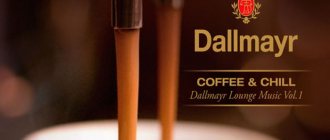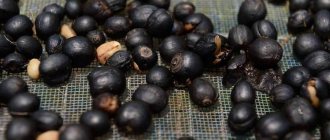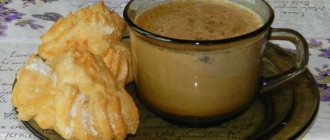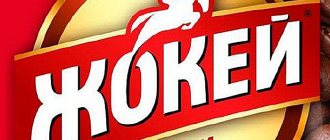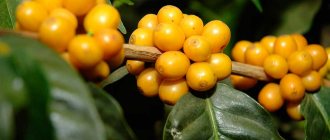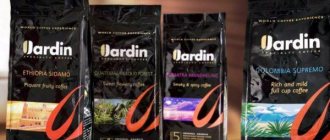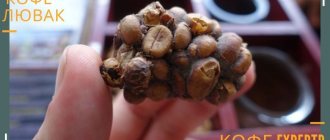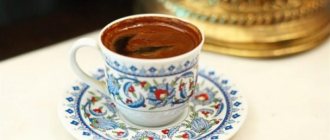Hausbrandt – coffee with soul!
This Italian company was founded in Triet in 1892.
One of the main components of the success of the Hausbrandt company, as the manufacturers themselves assure, is complete quality control, starting with the coffee bush and ending with the finished cup of fragrant coffee. Some people prefer to buy ground Hausbrandt coffee, but in this article we will talk about the holy of holies of any coffee lover - the bean product.
About the brand
The manufacturer is Hausbrandt, founded in Trieste (Italy) in 1982. Until now, the company's office is located in the same city. The brand is well known in the HoReCa environment; almost 20,000 restaurants around the world purchase Hausbrandt coffee for constant preparation.
The quality of the drink is above all praise. At one of the barista championships, company employees invited random people from the audience to take their place and offered them to make Hausbrandt coffee: the jury still recognized it as the best. This goes to show that even if you're not a professional, you can still make a great drink.
Preparation procedure and cooking
First, a careful selection of the most expensive Robusta and Arabica beans of the best quality takes place, which Hausbrandt buys from the main coffee exporting countries - Africa and Latin America. Afterwards, samples of the selected varieties are sent to the company, where they are analyzed by the company’s employees. Laboratory tests, which are mandatory to check the quality of Hausbrandt coffee, help to identify the quality of the product. Typically, testing includes microscopic and visual inspections, as well as further organoleptic and taste tests (i.e. in the form of a cup of finished espresso).
If all coffee samples meet the proposed quality standards, the entire batch is transported from the country of origin directly to the port of Trieste. Upon arrival of the cargo at the port, the next sample is sent back to the company to once again ensure its compliance with the tested sample. When the coffee passes all testing procedures, it is sent for roasting. Hausbrandt coffee is produced using slow roasting technology at a temperature of 210 °C. The process takes about 15-16 minutes, this helps to achieve a uniform color of coffee beans while maintaining the unique aroma and beneficial qualities of the beans. After roasting, the beans are immediately cooled to stop the natural combustion process. Then another series of tests is carried out in the analytical laboratory, during which the color and taste of the finished coffee are assessed.
The roasted coffee then travels to an external laboratory to test for metal residues, contaminants and caffeine content. As company employees say, all these series of examinations, procedures, checks, and double-checks make it possible to ensure that ideal taste and richness of the Hausbrandt coffee drink, which is so admired by enthusiastic coffee lovers.
Hausbrandt coffee beans are presented in the following variations: “Academy”, “Espresso”, “Gourmet”, “Venice”, “Oro Casa”, “Rossa”, “Superbar”.
Raw materials and production
For Hausbrandt coffee, the company purchases green beans, mainly from African plantations, as well as from Brazil, Central America, Jamaica and others. Arabica and Robusta beans are used.
Production is almost completely automated. In an area of 10 centimeters, a batch of beans is checked more than 30 times with special photocells that recognize and select immature, hard, deformed and similar unsuccessful beans. The final check is carried out by people to eliminate even the slightest defects.
The blends are compiled by the company's technologists; each variety is roasted and evaluated separately, and then mixed into blends. You always get the recognizable taste of your favorite product.
Coffee Gourmet
It is an exclusive blend of 100% highland Arabica from the best plantations in Latin America, Brazil, and the Caribbean islands for true gourmets and connoisseurs. It is Gourmet that has been rightfully considered one of the best varieties of Hausbrandt for about a hundred years.
According to reviews from coffee lovers, it has a delicate taste with a pleasant, noble sourness, unobtrusive hints of caramel, citrus and fruit with a soft honey aftertaste. To prepare it, use a medium Italian roast. The grain variety is 100% Arabica.
Hausbrandt coffee bar range
Coffee beans are purchased for coffee shops in large packages:
- Multi-faceted, well-balanced Academia drinks contain a slight and pleasant sourness. You can feel the Italian passion in them. Aftertaste with notes of cocoa. The drinks smell like tropical fruits.
- Toasted hazelnuts with a chocolate flavor are present in H. Hausbrandt. A drink with medium density, sweetness and spice. There is a slight sourness in it.
- You can feel the aftertaste with cocoa and licorice after thick SuperBar drinks, with sourness and the taste of freshly baked muffins.
- Dried fruits and baked goods remain after the strong Trieste drink. It has a pronounced natural sweetness, chocolate and licorice notes.
Rossa
This is a special mixture, which is formulated in accordance with ancient Italian technologies to create a first-class invigorating drink. According to customer reviews, it has a luxurious aroma and a subtle combination of flavors. “Rossa” has low acidity, all this thanks to the optimal ratio of robusta and arabica in its composition.
As coffee lovers say, it is not too strong, and this is only a plus, since you can feel its pleasant sweetness. Rossa grains have a special aroma of grain notes and fried bread.
Hausbrandt capsule coffee
There is a wider choice here. There are also unique blends:
- with ginseng flavoring in Ginseng;
- with a delicate floral aroma and almond aftertaste in Caffe Crema;
- with a pronounced bright flavor with dried fruits, in Espresso Sud;
- with smooth and balanced notes in Crema Gourmet;
- spicy, chocolate and fruity flavors in Indian drinks.
Read: Italian coffee brand Illy
Reviews
Reviews about this product are mostly positive. Coffee lovers fell in love with this Italian brand almost immediately. They claim that the coffee is excellent, it turns out with a red foam and sourness. Its taste is called the “golden mean”, since there are no extreme notes in it that would spoil the whole impression of it. For better expression of Arabica notes, coffee lovers advise using not freshly ground coffee, but one that was ground the day before use. This way the taste and aroma are revealed to the maximum. An excellent companion to this drink is dark chocolate, which complements the overall picture. Some even prefer to drink Hausbrandt coffee without milk or sugar to experience the true taste of the incredible drink. Of all the varieties, Gourmet coffee beans are the most popular.
Prices and where to buy
Hausbrandt coffee is priced above average - it is an elite product, and for more than a century, customers from different countries are willing to pay this price to enjoy the taste of a drink that has won international championships more than once. Here are some estimated prices to understand the segment:
- Academia, 1 kg, grain – 2400 rubles;
- Gourmet beans, 1 kg – 2600 rubles;
- Espresso, 1 kg – 1700 rub.;
- Columbus, jar, 250 g – 600 rub.;
- Gourmet can, 250 gr – 450 rub.;
- Espresso beans, canned, 250 g – 380 rub.;
- Decaf capsules, 50 pieces – 1850 RUR;
- Brazil Santos capsules, 10 pcs – 400 RUR;
- Pods, 72 pcs – 1800 – 2400 rubles.
A large selection of Hausbrandt coffee is available in specialized online stores, where you can also find exclusive varieties, and some not described by us. In retail, you need to look for coffee and tea in stores; sometimes you can buy products in large supermarkets.
Addresses and telephone numbers of coffee shops in Moscow
A list of addresses is provided on the company’s official website, here are some of them:
- Arbatskaya, 1, tel: 8-906-721-73-84
- Pervomaiskaya, 35\18, tel: 8-968-792-71-24
- Izmailovskoe highway, 71a, tel: 8-965-157-17-97
- Shcherbakovskaya, 8, tel: 8-963-610-65-47
- Sokolnicheskaya Square, 9, bldg. 1, tel: −8-968-792-70-85
- Shopping center "Auchan City Maryina Roshcha", Sheremetyevskaya, 20, tel: 8-909-953-01-97
- Dmitrovskoe highway, 15, building 1, tel: 8-968-792-70-86
- Snezhnaya, 26, tel: 8-965-157-34-68
- Shopping center "Golden Babylon", Dekabristov, 12, tel: 8-903-727-81-74
- Shopping center "Kaleidoscope", Skhodnenskaya, 56, tel: 8-965-157-30-72
- Leningradsky Prospekt, 74, building 1, tel: 8-909-952-94-19
- Leningradsky Prospekt, 62, tel: 8-964-577-75-21
- Brestskaya 2nd street, 43, tel: 8-968-792-70-98
- Gruzinsky Lane, 4, tel: 8-968-792-71-01
- Prospekt Mira, 42, tel: 8-965-167-26-44
- Sretenka, 36\2, building 3, tel: 8-968-792-70-99
- Tsvetnoy Boulevard, 21, building 1, tel: 8-909-992-10-28
- Shopping center "Legend of Tsvetnoy", Tsvetnoy Boulevard, 2, building 1, tel: 8-964-577-54-62
- Tverskaya street, 19, tel: 8-903-727-81-54
- Kudrinskaya Square, 1, tel: 8-974-577-58-90
- Bolshaya Nikitskaya street, 23\14\9, building 2, tel: 8-903-727-82-37
- Nikolskaya, 11-13, building 5, tel: 8-909-953-02-64
- Shopping center "Okhotny Ryad", Manezhnaya square, 1, building 2, tel: 8-964-577-73-42
- Bolshoi Tolmachevsky lane, 4, building 1, tel: 8-905-722-50-60
What kind of coffee is used: beans, ground, instant?
Green coffee beans, packaged in polypropylene or jute bags, are brought from Europe. Roasted coffee is brought from Germany and Italy.
Types of coffee such as granulated and instant coffee are not used in coffee shops.
An experienced barista can offer a visitor several dozen famous varieties of coffee. They prepare 9 varieties of cappuccino, 5 varieties of espresso: Americano, Romano, Macchiato, Con Panna, and Classic.
History of discovery and distribution in Russia
In September 1999, the first Coffee House coffee shop was opened in the capital's new shopping mall on Tverskaya. The menu was simple and straightforward: fresh pastries and sweets, high quality coffee, sandwiches and good alcohol. The place immediately attracted the attention of the capital’s “golden” youth.
The name "Coffee House" originally appeared. But its sound in Russian seemed “heavy” and it was decided to settle on “Coffee House”.
The network grew slowly but surely: within a year, 4 more “points” were opened. The question arose about an experienced manager. In 2000, Vladislav Dudakov was invited to the post of general director. This young but ambitious manager received an economics education in the USA and managed to work for McDonald's for 11 years, making his way from an ordinary employee to a restaurant manager. Dudakov got down to business with enthusiasm: Khairutdinov offered him an option for 5% of the shares (1% per year of work) and gave him unlimited powers to resolve all significant issues.
After 3 years, Coffee House increased the number of its coffee shops 10 times. In December 2003, the establishment was opened on Bolshaya Konyushennaya in St. Petersburg, and in 2006 there were already more than 30 of them.
When Dudakov learned that a chain of St. Petersburg coffee shops was preparing to open its first location in Moscow, he made every effort to get ahead of them. “We must appear there earlier: a day, an hour, five minutes, but earlier.” The idea was a success - Coffee House was two days ahead of Chashka.
The shareholders' thoughts about saving raw materials resulted in the construction of their own coffee roasting workshop. With an allocated amount of $3 million, an enterprise with a capacity of 30,000 tons per month was built. Over time, its own workshop for the production of confectionery products was created.
History of origin and distribution
The popularity of coffee consumption in Russia continues to gain momentum. Timur Khairutdinov, at that time already an experienced entrepreneur and owner of an entertainment club, also understood this. He brought the idea of opening a coffee shop from Italy, after visiting one of the most sophisticated establishments in Milan. And this idea clearly had great prospects - the capital at that time could boast of the only such establishment called “Coffee Bean” in a couple of retail outlets.
Khairutdinov relied on a quick start. The hired bartenders were sent to Italy to learn the intricacies of the craft from the famous barista Giuseppe Grasse. And a few years later, the Coffee House chain could boast of two hundred coffee shops throughout Russia.
Coffee lovers' opinions
Users give the coffee 4.5-5 /5 points.
Oleg, Moscow: “Coffee is beyond praise. I also like the bitterness and sourness. The drinks turn out to be refined due to the dense reddish foam.”
Pavel, Kaluga: “On occasion, my wife and I bought coffee. It turned out to be strong. I love this one. The wife adds cream. We really liked this brand.”
Baristas also rate this product highly.
Barista, Igor: “My guests like Hausbrandt coffee, no matter what method of preparation I offer them.”
The proposed range of coffee drinks and their calorie content
Visitors to the Coffee House can choose from a wide range of drinks to suit every taste:
- A cup of espresso coffee (30 ml) contains 8.6 kcal;
- iced glass (230 ml) - 204.8 kcal
- espresso Americano (250 ml) - 17 kcal;
- The calorie content of classic Mocha (220 ml) is 131.6 kcal, with the addition of strawberry or caramel syrup it increases to 163 kcal;
- The calorie content of a classic Latte varies from 89 to 179 (depending on the volume of the cup and the characteristics of the milk added);
- Cappuccino with skim milk contains 52 kcal (200 ml) and 83 kcal (350 ml).
